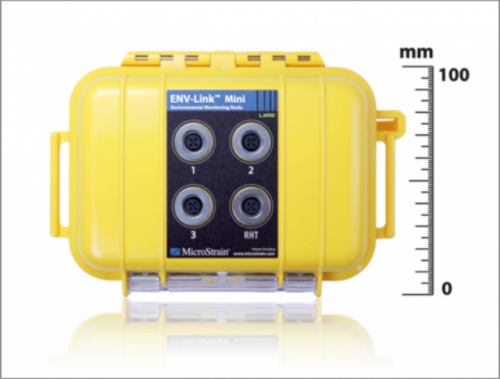has introduced ENV-Link -Mini, which simplifies and streamlines remote environmental monitoring, alerting & reporting.
This long-range, low-power environmental sensing solution is ideal for remote applications that demand scalable monitoring, simple initialization and easy access to data.
With the new ENV-Link -Mini, users can quickly and cost-effectively establish custom environmental sensing networks. Miniature, multi-channel wireless nodes support an array of sensor types for versatile configuration.
Each ENV-Link -Mini supports four sensor channels in an IP67 weatherproof enclosure. In addition to a dedicated relative humidity and temperature channel, users may select from environmental sensors including solar radiation, soil moisture, leaf wetness, and the option to add their own sensor. Wireless communication extends up to 2km line-of-sight for enhanced remote sensing over a wider area and across thousands of nodes.
The ENV-Link® -Mini utilizes MicroStrain’s LXRS™ wireless protocol enabling 100% data reliability under normal operating conditions. Furthermore, nodes can be deployed for up to 5 years without replacing batteries.
Combined with MicroStrain’s cloud-based sensor data platform, SensorCloud™, ENV-Link -Mini users can cost-effectively access unlimited environmental data. On SensorCloud™ users can quickly navigate environmental data, analyze trends and create alerts, which notify key personnel when environmental thresholds are exceeded.
ENV-Link wireless environmental monitoring nodes will find immediate uses. Solar radiation site surveys can deploy them for return on investment (ROI) energy estimations. Data from distributed networks of ENV-Link nodes – archived in the cloud – also supports a wide range of applications in environmental monitoring and precision farming. These include: improved commercial agricultural operations for vineyards, plantations, and golf courses. ENV-Link’s sensor data can be used to improve predictive models of plant health and related entymological impacts that are associated with stressful environmental conditions. These data can help towards reducing the use of herbicides and pesticides, which, in turn, will lead to cost savings for farmers.
MicroStrain President and CEO Steve Arms said “Remote monitoring of sunlight, soil moisture, humidity and leaf wetness will help us to conserve our precious soil and water resources. Archiving environmental data in the cloud over the long term, and sharing these data with researchers worldwide, has the potential to improve our understanding of and our ability to respond to global climate change.”
Source: Press Release

